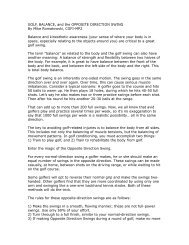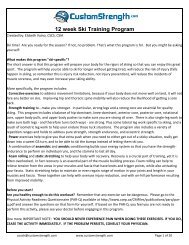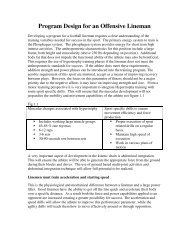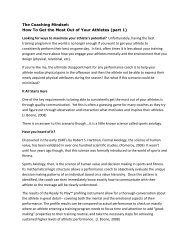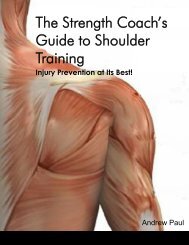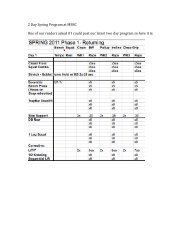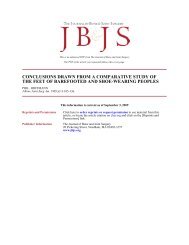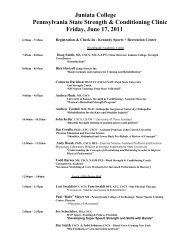Sprint Interval Training - “It's a HIIT - Strength Coach.com
Sprint Interval Training - “It's a HIIT - Strength Coach.com
Sprint Interval Training - “It's a HIIT - Strength Coach.com
You also want an ePaper? Increase the reach of your titles
YUMPU automatically turns print PDFs into web optimized ePapers that Google loves.
supplementing their “low‐ to moderate‐intensity” <strong>HIIT</strong> with a significant amount of supra‐maximal <strong>HIIT</strong>. This<br />
thought is supported by a study that investigated the relationship between tests of anaerobic (non‐oxidative<br />
metabolism) power and 10K running performance and which demonstrated that all tests of anaerobic power were<br />
significantly correlated with 10K run time and just one plyometric leap test accounted for nearly 75% of the<br />
variance in 10K run time 1 . When <strong>com</strong>bined with the 300‐m sprint time, the variance in 10K run time increased to<br />
nearly 80%. However, the wisdom of my re<strong>com</strong>mendation to the endurance athlete is relatively unimportant<br />
when one considers that the most pressing issue for society is getting the general public to engage in a successful<br />
exercise program that improves their overall health, not to help them cross the finish line in April near Fenway<br />
Park.<br />
Superior Benefits of High‐Intensity Intermittent Exercise<br />
So, back to the education about the superior health and fitness benefits of <strong>HIIT</strong>. I have been at the<br />
forefront of this issue since the mid‐1990s and, I can say with experience, it has been an uphill battle to undo some<br />
very indoctrinated thinking. The reason for this indoctrination is likely due to a number of causes – chief among<br />
them is the fact that early sport science research focused, from a relative perspective, almost exclusively, on<br />
LMICT. This then led to a saturation of the scientific journals with this type of research. So why this focus?<br />
Historical Perspective of Exercise Re<strong>com</strong>mendations<br />
One can never be certain as to why history takes its course; however, in my opinion, a pioneering article<br />
by Hollowszy in 1967 likely led the way for a concentrated examination of the effect continuous exercise had on<br />
oxidative metabolism 2 . The study demonstrated a twofold increase in mitochondrial enzymes (i.e., an increase in<br />
aerobic capacity) of rat skeletal muscle in response to strenuous treadmill running. While the majority of the early<br />
studies that followed continued to focus on the effect continuous exercise had on oxidative metabolism, some<br />
researchers did examine <strong>HIIT</strong>. Interestingly, Hollowszy’s running protocol, by the end of the 12‐week training<br />
period, included 12, 30‐second sprints. Unfortunately, the physiological effect of the sprints was not differentiated<br />
from the majority of the continuous running by the rats. Edwards, et al. conducted the first detailed analysis of<br />
3



